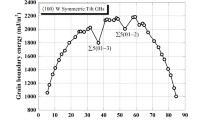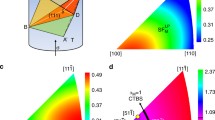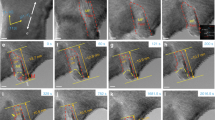Abstract
Migration of symmetric tilt grain boundaries (STGBs) in face-centered cubic (FCC) metals under shear loading is investigated in this work. The STGBs have a tilt axis of [110], and the angle \(\theta\) between the \((1\overline{1 }\overline{1 })\) invariant planes ranges from 8° up to 28° with a 2° increment. Interesting phase transformation and twinning are observed during GB migration in Cu, Ni but not in Al. The results show that for low values of \(\theta\), under shear loading, a hexagonal close-packed (HCP) phase is formed along the original GB and the HCP phase grows via shear coupling of one of the two interfaces between the HCP and the FCC grain. As \(\theta\) increases, both interfaces between the HCP and the grains become mobile and the HCP region traverses and transforms the lattice of one grain into the other. Thus, shear coupling is accomplished and facilitated through FCC → HCP → FCC phase transformations. As \(\theta\) further increases to 18° and greater, instead of FCC → HCP phase transformation, a {111} twin is formed along the original GB. The twin expands via shear coupling of the new GB between the twin and the FCC grain. Lattice correspondences are carefully analyzed for the phase transformation and twinning. The analyses indicate that the mobility of GBs is predominantly determined by how readily lattice transformation can be accomplished. The lattice correspondence in HCP twinning modes provide key insight on the observed GB migration behavior.
















Similar content being viewed by others
Data and code availability
The original data of this work are available from the corresponding author (binl@iastate.edu) upon request.
References
Cahn JW, Mishin Y, Suzuki A (2006) Coupling grain boundary motion to shear deformation. Acta Mater 54:4953–4975
Molodov DA, Gorkaya T, Gottstein G (2011) Dynamics of grain boundaries under applied mechanical stress. J Mater Sci 46:4318–4326. https://doi.org/10.1007/s10853-010-5233-6
Molodov DA, Gorkaya T, Gottstein G (2011) Migration of the Σ7 tilt grain boundary in Al under an applied external stress. Scr Mater 65:990–993
Fukutomi H, Kamijo T (1985) Grain boundary sliding-migration of aluminum 〈110〉Σ11 {113} symmetric tilt coincidence grain boundary and its interpretation based on the motion of perfect DSC dislocations. Scr Metall 19:195–197
Cahn JW, Mishin Y, Suzuki A (2006) Duality of dislocation content of grain boundaries. Philos Mag 86:3965–3980
Caillard D, Mompiou F, Legros M (2009) Grain-boundary shear-migration coupling. II. Geometrical model for general boundaries. Acta Mater 57:2390–2402
Deng Y, Deng C (2017) Size and rate dependent grain boundary motion mediated by disconnection nucleation. Acta Mater 131:400–409
Han J, Thomas SL, Srolovitz DJ (2018) Grain-boundary kinetics: a unified approach. Prog Mater Sci 98:386–476
Molodov KD, Molodov DA (2018) Grain boundary mediated plasticity: on the evaluation of grain boundary migration-shear coupling. Acta Mater 153:336–353
Brandon DG (1966) The structure of high-angle grain boundaries. Acta Metall 14:1479–1484
Bilby BA, Crocker AG (1965) The theory of the crystallography of deformation twinning. Proc R Soc Lond Ser Math Phys Sci 288:240–255
Christian JW, Mahajan S (1995) Deformation twinning. Prog Mater Sci 39:1–157
Li B, Leung J (2021) Lattice transformation in grain boundary migration via shear coupling and transition to sliding in face-centered-cubic copper. Acta Mater 215:117127
Homer ER, Foiles SM, Holm EA, Olmsted DL (2013) Phenomenology of shear-coupled grain boundary motion in symmetric tilt and general grain boundaries. Acta Mater 61:1048–1060
Wan L, Wang S (2009) Shear response of the Σ11, 〈110〉{131} symmetric tilt grain boundary studied by molecular dynamics. Model Simul Mater Sci Eng 17:045008
Wan L, Wang S (2010) Shear response of the Σ9 〈110〉{221} symmetric tilt grain boundary in fcc metals studied by atomistic simulation methods. Phys Rev B 82:214112
Daw MS, Baskes MI (1983) Semiempirical, quantum mechanical calculation of hydrogen embrittlement in metals. Phys Rev Lett 50:1285–1288
Daw MS, Baskes MI (1984) Embedded-atom method: derivation and application to impurities, surfaces, and other defects in metals. Phys Rev B 29:6443–6453
Mishin Y, Mehl MJ, Papaconstantopoulos DA et al (2001) Structural stability and lattice defects in copper: ab initio, tight-binding, and embedded-atom calculations. Phys Rev B 63:224106
Mishin Y, Farkas D, Mehl MJ, Papaconstantopoulos DA (1999) Interatomic potentials for monoatomic metals from experimental data and ab initio calculations. Phys Rev B 59:3393–3407
Hoover WG (1985) Canonical dynamics: equilibrium phase-space distributions. Phys Rev A 31:1695–1697
Nosé S (1984) A unified formulation of the constant temperature molecular dynamics methods. J Chem Phys 81:511–519
Plimpton S (1995) Fast parallel algorithms for short-range molecular dynamics. J Comput Phys 117:1–19
Stukowski A (2010) Visualization and analysis of atomistic simulation data with OVITO–the open visualization tool. Model Simul Mater Sci Eng 18:015012
Honeycutt JD, Andersen HC (1987) Molecular dynamics study of melting and freezing of small Lennard-Jones clusters. J Phys Chem 91:4950–4963
Rittner JD, Seidman DN, Merkle KL (1996) Grain-boundary dissociation by the emission of stacking faults. Phys Rev B 53:R4241–R4244
Christian JW (2002) The theory of transformations in metals and alloys. Newnes
Niewczas M (2010) Lattice correspondence during twinning in hexagonal close-packed crystals. Acta Mater 58:5848–5857
Song SG, Gray GT (1995) Transmission electron microscopy examination and analysis of an anomalous stacking fault in h.c.p. metals. Philos Mag A 71:263–274
Zinkle SJ, Seitzman LE, Wolfer WG (1987) I. Energy calculations for pure metals. Philos Mag A 55:111–125
Varvenne C, Mackain O, Clouet E (2014) Vacancy clustering in zirconium: an atomic-scale study. Acta Mater 78:65–77
Wu XL, Li B, Ma E (2007) Vacancy clusters in ultrafine grained Al by severe plastic deformation. Appl Phys Lett 91:141908
Hirth JP, Lothe J (1983) Theory of dislocations, 2nd edn. Krieger Publishing Company
Zhang XY, Li B, Liu Q (2015) Non-equilibrium basal stacking faults in hexagonal close-packed metals. Acta Mater 90:140–150
Li B, Sun Q, Zhang XY (2021) Lattice correspondence analysis on the formation mechanism for partial stacking faults in hexagonal close-packed metals. Comput Mater Sci 198:110684
Sun Q, Zhang Q, Li B et al (2017) Non-dislocation-mediated basal stacking faults inside {1011}〈1012〉 twins. Scr Mater 141:85–88
Zhou B, Sui M (2019) High density stacking faults of {1011} compression twin in magnesium alloys. J Mater Sci Technol 35:2263–2268
Li B, Ma E (2009) Zonal dislocations mediating twinning in magnesium. Acta Mater 57:1734–1743
Minonishi Y, Ishioka S, Koiwa M, Mobozumi S (1982) The structure of {1121} twin boundaries in H.C.P. crystals. Phys Status Solidi A 71:253–258
Li B, El Kadiri H, Horstemeyer MF (2012) Extended zonal dislocations mediating twinning in titanium. Philos Mag 92:1006–1022
Li J, Sui M, Li B (2021) A half-shear-half-shuffle mechanism and the single-layer twinning dislocation for {1122}〈1123〉 mode in hexagonal close-packed titanium. Acta Mater 216:117150
Chen P, Ombogo J, Li B (2020) Dislocation ↔ twin transmutations during interaction between prismatic slip and {1011} twin in magnesium. Acta Mater 186:291–307
Song SG, Gray GT III (1995) Structural interpretation of the nucleation and growth of deformation twins in Zr and Ti—I. Application of the coincidence site lattice (CSL) theory to twinning problems in h.c.p. structures. Acta Metall Mater 43:2325–2337
Song SG, Gray GT III (1995) Structural interpretation of the nucleation and growth of deformation twins in Zr and Ti—II. Tem study of twin morphology and defect reactions during twinning. Acta Metall Mater 43:2339–2350
Li B, Ma E (2009) Atomic shuffling dominated mechanism for deformation twinning in magnesium. Phys Rev Lett 103:035503
Li B, Zhang XY (2016) Twinning with zero twinning shear. Scr Mater 125:73–79
Li B, Zhang XY (2014) Global strain generated by shuffling-dominated twinning. Scr Mater 71:45–48
Hirth JP, Wang J, Tomé CN (2016) Disconnections and other defects associated with twin interfaces. Prog Mater Sci 83:417–471
Dang K, Wang S, Gong M et al (2020) Formation and stability of long basal-prismatic facets in Mg. Acta Mater 185:119–128
Chen K, Han J, Thomas SL, Srolovitz DJ (2019) Grain boundary shear coupling is not a grain boundary property. Acta Mater 167:241–247
Combe N, Mompiou F, Legros M (2016) Disconnections kinks and competing modes in shear-coupled grain boundary migration. Phys Rev B 93:024109
Yoo MH (1981) Slip, twinning, and fracture in hexagonal close-packed metals. Metall Trans A 12:409–418
Liu B-Y, Zhang Z, Liu F et al (2022) Rejuvenation of plasticity via deformation graining in magnesium. Nat Commun 13:1060
Liu B-Y, Liu F, Yang N et al (2019) Large plasticity in magnesium mediated by pyramidal dislocations. Science 365:73–75
Kou Z, Yang Y, Yang L et al (2019) In situ atomic-scale observation of a novel lattice reorienting process in pure Ti. Scr Mater 166:144–148
Chen P, Wang F, Li B (2019) Transitory phase transformations during 1012 twinning in titanium. Acta Mater 171:65–78
Chen P, Wang F, Li B (2019) Misfit strain induced phase transformation at a basal/prismatic twin boundary in deformation of magnesium. Comput Mater Sci 164:186–194
He Y, Li B, Wang C, Mao SX (2020) Direct observation of dual-step twinning nucleation in hexagonal close-packed crystals. Nat Commun 11:2483
Mahajan S, Chin GY (1973) Formation of deformation twins in f.c.c. crystals. Acta Metall 21:1353–1363
Li B, Cao BY, Ramesh KT, Ma E (2009) A nucleation mechanism of deformation twins in pure aluminum. Acta Mater 57:4500–4507
Kibey S, Liu JB, Johnson DD, Sehitoglu H (2007) Predicting twinning stress in fcc metals: linking twin-energy pathways to twin nucleation. Acta Mater 55:6843–6851
Tadmor EB, Bernstein N (2004) A first-principles measure for the twinnability of FCC metals. J Mech Phys Solids 52:2507–2519
Li BQ, Sui ML, Li B et al (2009) Reversible twinning in pure aluminum. Phys Rev Lett 102:205504
Vítek V (1968) Intrinsic stacking faults in body-centred cubic crystals. Philos Mag 18:773–786
Rodney D, Ventelon L, Clouet E et al (2017) Ab initio modeling of dislocation core properties in metals and semiconductors. Acta Mater 124:633–659
Acknowledgements
B.L. gratefully thanks the support from National Science Foundation, USA, under grant number CMMI-2016263 and 2032483.
Author information
Authors and Affiliations
Contributions
BL contributes to the design and execution of simulations, analyses, manuscript writing; KFC contributes to the simulations and analyses.
Corresponding author
Ethics declarations
Conflict of interest
The authors declare no conflicts of interest or competing interests.
Ethical approval
No human tissue is involved in this work.
Additional information
Handling Editor: N. Ravishankar.
Publisher's Note
Springer Nature remains neutral with regard to jurisdictional claims in published maps and institutional affiliations.
Supplementary Information
Below is the link to the electronic supplementary material.
Rights and permissions
Springer Nature or its licensor (e.g. a society or other partner) holds exclusive rights to this article under a publishing agreement with the author(s) or other rightsholder(s); author self-archiving of the accepted manuscript version of this article is solely governed by the terms of such publishing agreement and applicable law.
About this article
Cite this article
Li, B., Chen, K. Grain boundary migration facilitated by phase transformation and twinning in face-centered cubic metals. J Mater Sci 58, 14740–14757 (2023). https://doi.org/10.1007/s10853-023-08863-z
Received:
Accepted:
Published:
Issue Date:
DOI: https://doi.org/10.1007/s10853-023-08863-z




